Growing strawberries in a container is like having your own little sweet factory right on your balcony or patio. You get to skip the supermarket line and enjoy the juicy, delicious fruits of your labor without ever leaving your home. Plus, you’ll feel like a real farmer, except instead of a tractor, you’ve got a watering can and a container full of dirt. Whether you’re a sprout or a seasoned green thumb, container gardening is the perfect way to add a little bit of color to your living space. So, grab your trowel and get ready to plant yourself firmly in the world of container gardening, as we explain how to grow strawberries in a pot!
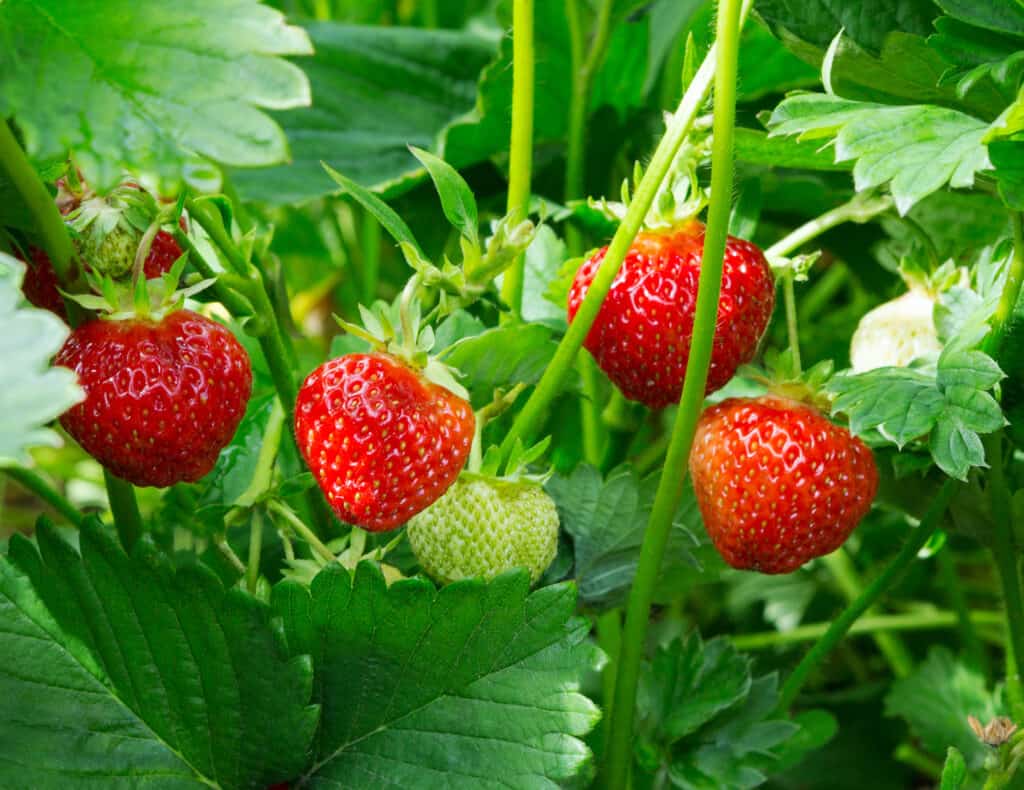
©iStock.com/romiri
How to Grow Strawberries in a Pot: What is a Strawberry
A strawberry (Fragaria) is a sweet, juicy fruit beloved across the globe for its intoxicating flavor and aroma. Strawberries are rich in vitamins and antioxidants, making them a healthful and nutritious snack. The fruit is red and heart-shaped, with small seeds on the outside and a fleshy interior. Strawberries are typically eaten fresh, but they can also be used in a variety of desserts, jams, and sauces. The plants themselves are low-growing perennials, with dark green leaves and delicate white flowers that give way to the fruit. Strawberries are grown around the world and are a popular crop for both commercial and home gardeners. Keep reading to discover how to grow these healthful, tasty treats!
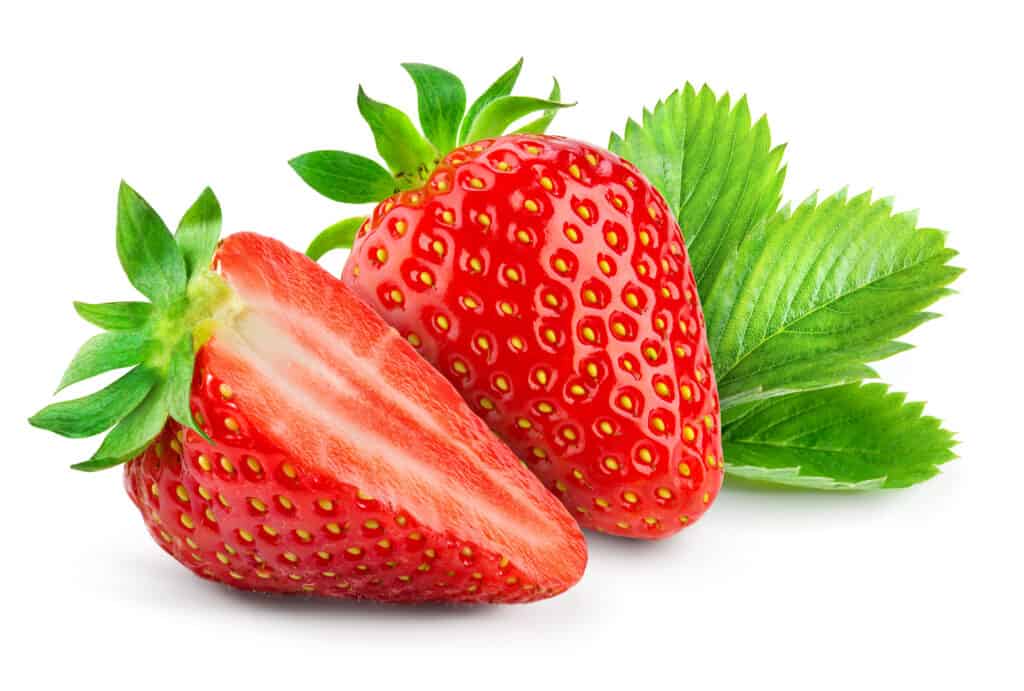
©Tim UR/Shutterstock.com
How to Grow Strawberries in a Pot: Necessary Materials
Before you get down to the business of planting your strawberry seeds or bedding plants, you’ll need to gather the following items:
- A pot with drainage holes (at least 6 inches deep and 12 inches wide)
- Potting soil
- Strawberry seeds or seedlings
- Watering can or hose
Optional:
- Gardening gloves
- Hand trowel
- Fertilizer

©Sofiaworld/Shutterstock.com
How to Grow Strawberries in a Pot: Selecting a Cultivar
There are over 600 different varieties of strawberries grown worldwide. These varieties can vary in size, color, flavor, and even the time of year that they produce fruit. When choosing a variety to grow, consider factors such as the climate in your area, the time of year you wish to harvest, and your own personal taste preferences. Some of the easiest and best varieties of strawberries for container gardening include:
- Everbearing strawberries: These varieties produce fruit throughout the growing season, rather than just once per year. They are a good choice for container growing because they tend to have a more compact growth habit and produce smaller, but more frequent harvests.
- Day-neutral strawberries: Similar to everbearing strawberries, day-neutral varieties produce fruit throughout the growing season. They are also a good choice for container growing because they tend to have a smaller growth habit and can be grown successfully in smaller containers.
- Ozark Beauty strawberries: This variety is well-suited for container growing because it has a compact growth habit and produces large, juicy berries. It also has a high resistance to diseases and pests, making it a low-maintenance option for container gardening.
- Seascape strawberries: Seascape plants produce large, sweet berries. These plants are also practically impervious to heat and will continue to fruit throughout the summer. Seascape is a good choice for container growing because it has a more compact growth habit than some other strawberry varieties and can be grown successfully in smaller containers.

©nadia_if/Shutterstock.com
These are just a few examples of the many varieties of strawberries available. When selecting strawberries for container gardening, it’s wise to choose varieties that have a more compact growth habit and are well-suited for smaller spaces. With proper care and maintenance, these varieties can produce a bountiful harvest of sweet, delicious berries.
How to Grow Strawberries in a Pot: Selecting a Container
When it comes to selecting a container for planting strawberries, there are a variety of options to choose from. One popular choice is the traditional terra cotta strawberry jar, which is designed specifically for growing strawberries. These jars have multiple pockets or openings along the sides, allowing for several plants to be grown in one container. However, other types of containers such as hanging baskets, or even repurposed items like old buckets or pallets can also work well for growing strawberries.

©Dawn Balaban/Shutterstock.com
When selecting a container, it’s important to consider factors such as drainage, size, and material. Strawberries require good drainage to prevent the roots from becoming waterlogged, so be sure to choose a container with adequate drainage holes. Look for a pot that is at least 6 inches deep and 12 inches wide. It’s a good idea to choose a pot that is big enough to accommodate several plants as strawberries are best grown in clusters.
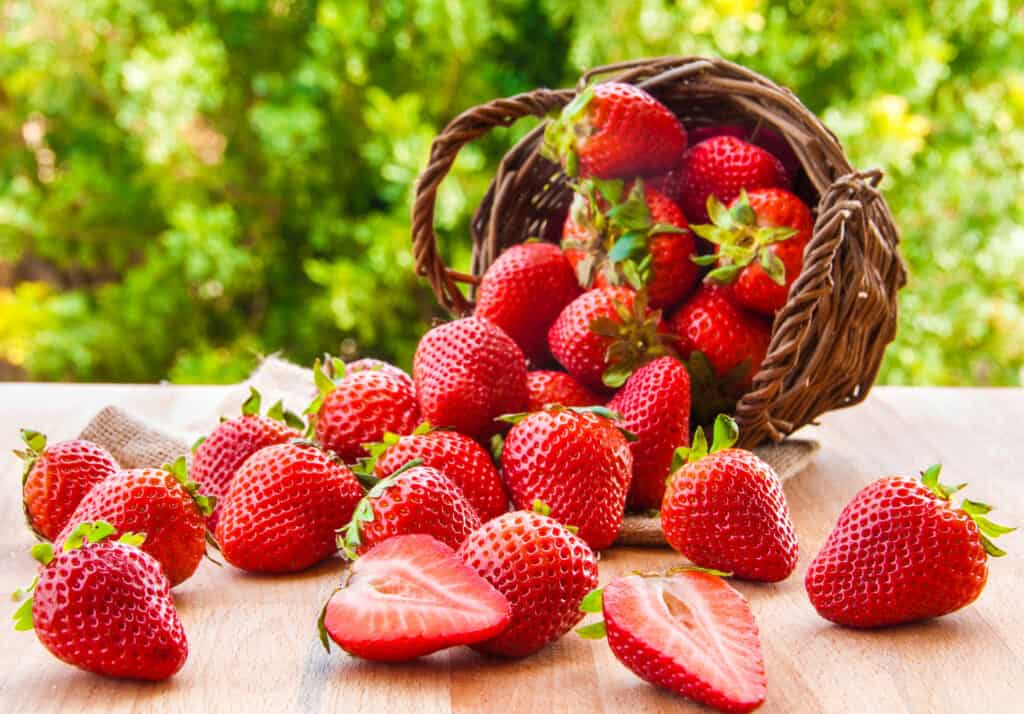
©iStock.com/MariaUspenskaya
How to Grow Strawberries in a Pot: Preparing the Container
Several factors are at play in preparing your container for planting. At this stage, thinking ahead can save you loads of time and eliminate unnecessary aggravation. Decide where you’re going to place your container prior to filling it with soil. Depending on the size of your strawberry pot, it could be incredibly difficult to move once it has been filled with soil. Because strawberries need a minimum of 6 hours of direct sunlight daily to fruit, you’ll need to choose a location that receives the most sunshine and place your container there. If you have chosen a container that doesn’t have drainage holes, this would be the time to fashion some, if possible. Get tips for creating DIY drain holes here.

©Agenturfotografin/Shutterstock.com
Once the holes have been made and the container has been placed it’s time to add your planting medium. Strawberries grow best in well-draining, loamy, sandy soil. If you will be using commercial potting soil, it’s important that you amend it with organic compost or aged manure, and organic fertilizer that is higher in potassium than nitrogen, which is a basic 8-12-32 fertilizer, available at garden centers and online. Fill the pot with the amended potting soil, leaving 1-2 inches (2.5-5 cm) of space at the top, to accommodate the seedlings or seeds.
How to Grow Strawberries in a Pot: Sowing the Seed or Planting the Plants
If you’re planting seeds, sprinkle them over the soil surface and cover them with a thin layer of soil. If you’re using seedlings, gently loosen their roots and plant them at the same depth they were growing in their previous container. Once you’ve planted your strawberries, give them a good drink of water.
Growing Strawberries from Seed
Growing strawberries from seed takes several months. It takes 2-3 weeks for strawberry seeds to germinate, and then another 2-3 weeks for the seedlings to become established. Once the seedlings have developed their first true leaves, thin them out by removing extras, allowing 6-8 inches (15-20 cm) between the remaining seedlings. This gives them room to grow and spread. It takes from 3-4 months for the plants to produce fruit, depending on the variety and growing conditions.
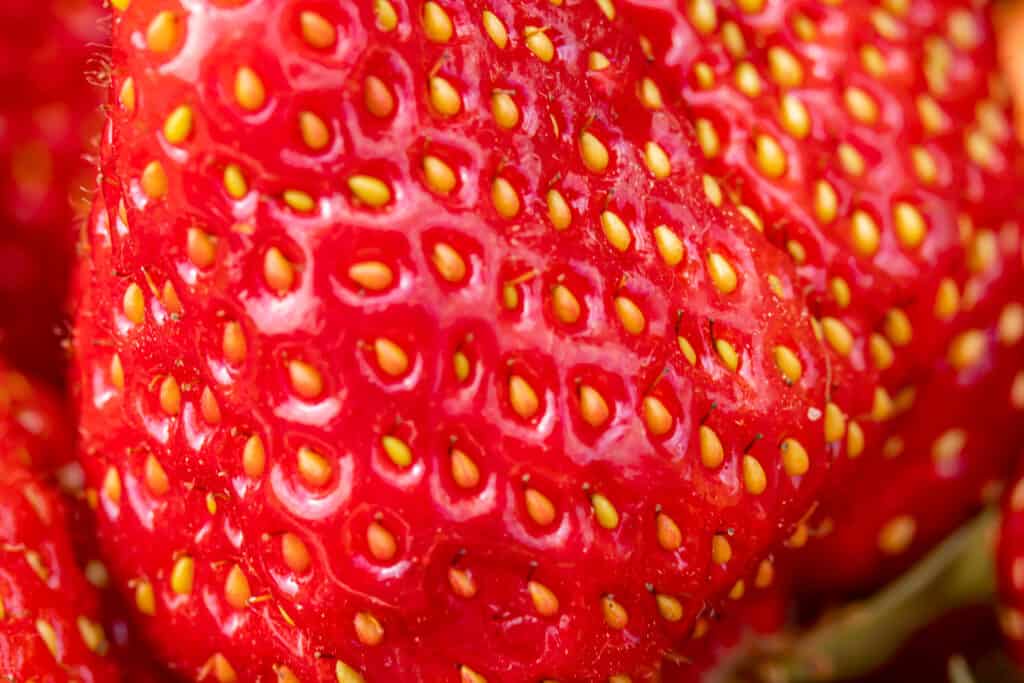
©iStock.com/Oleg Prolat
Most strawberry plants started from seed will not produce fruit during their first year of growth. Instead, they will focus their energy on establishing their roots and foliage. However, there are a few exceptions to this rule, such as some everbearing varieties of strawberries, which may produce a small crop in their first year. But by and large, you’ll probably have to wait until the second year before expecting a significant harvest from your strawberry plants.
Growing Strawberries from Bedding Plants
Strawberry bedding plants are young, established plants that have been propagated asexually from a runner or cutting, rather than grown from seed. These plants are often sold in nurseries or garden centers and are already mature enough to start producing fruit. When transplanting, the crown of the strawberry plant (where the roots meet the stem) should be level with the soil surface or just slightly above it. The recommended spacing for container strawberry plants is 8-12 inches (20-30 cm).
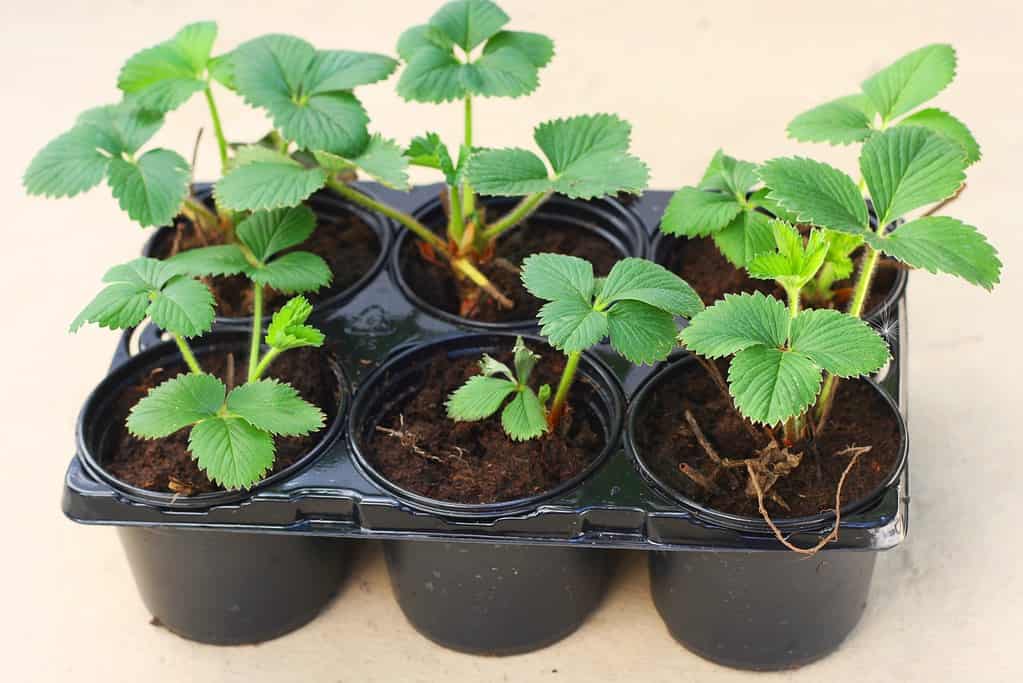
©padu_foto/Shutterstock.com
Approximately 4-6 weeks after planting strawberry bedding plants, the plant begins producing fruit. However, the timing can vary depending on the variety of strawberries, the growing conditions, and the age and size of the plants at the time of purchase. While strawberry plants can produce fruit in their first year, the first harvest is usually smaller than subsequent harvests. As the plant matures and establishes a strong root system, it will be able to produce larger and more abundant fruit in subsequent years. With proper care and maintenance, a healthy strawberry plant can continue to produce fruit for several years.
How to Grow Strawberries in a Pot: Location, Location, Loction!!!
Growing strawberries in a container can be a great way to enjoy fresh, delicious berries even if you live in an area with harsh winters or limited outdoor space. However, the success of your container strawberry plants will depend on the USDA Hardiness Zone you call home. If you’re unsure of your area’s zone you can discover it here. Growing strawberries in a pot in different USDA hardiness zones have distinct requirements as follows:
Cooler Zones
Zone 1-3: These zones are too cold for most strawberry plants to survive outdoors. However, you can still grow strawberries in containers indoors or in a greenhouse, as long as you provide enough light, warmth, and humidity.
Zone 4-6: These zones are suitable for growing most types of strawberry plants, including June-bearing, everbearing, and day-neutral varieties. You may need to protect your plants from frost during the winter months, but otherwise, they should thrive in a container outdoors.

©AVN Photo Lab/Shutterstock.com
Warmer Zones
Zone 7-9: These zones are ideal for growing strawberries, as they provide the warm temperatures and long growing season that strawberries love. You can grow a variety of different strawberry plants in containers, and they should do well with proper care and maintenance.
Zone 10-11: These zones are also suitable for growing strawberries in containers, but you will need to protect your plants from the intense heat and sun. Consider placing your containers in a partially shaded area or using shade cloth to protect your plants from sun damage.
Regardless of the zone you live in, there are a few tips to keep in mind when growing strawberries in containers. First, make sure your containers have good drainage to prevent waterlogged soil. Second, choose a high-quality potting mix and fertilize regularly to provide your plants with the nutrients they need to thrive. Third, keep your plants well-watered, especially during hot or dry weather. With these tips and the right variety of strawberries, you can enjoy a bountiful harvest of delicious berries right from your own container garden
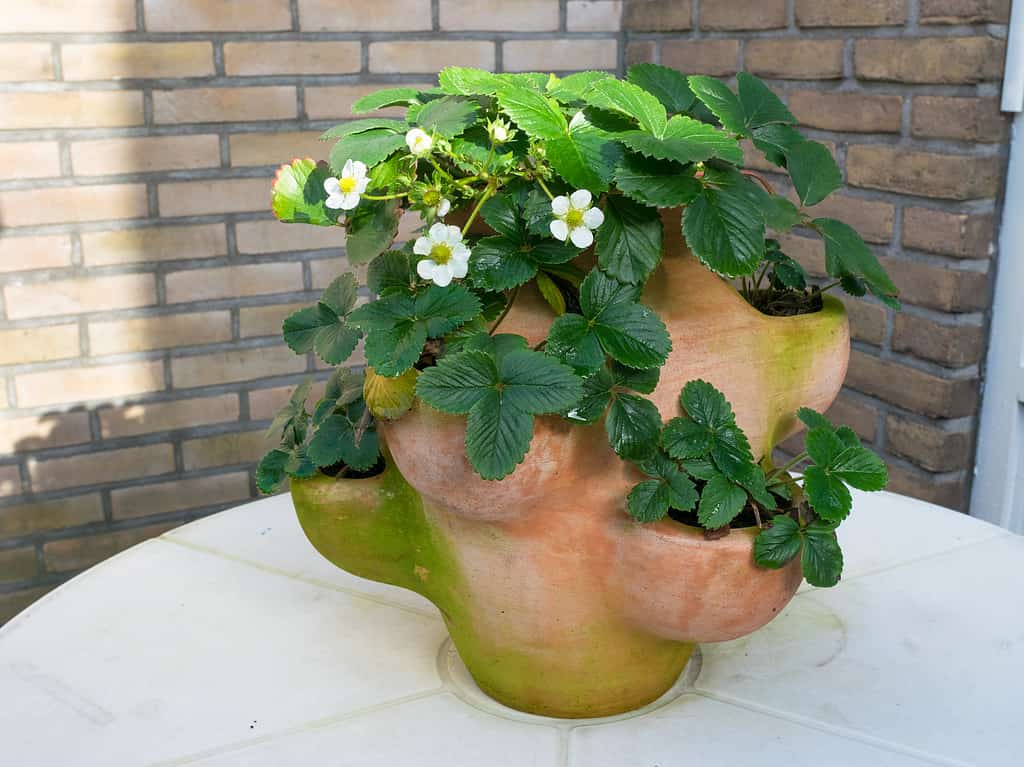
©Menno van der Haven/Shutterstock.com
Five Fascinating Facts about Fraise*
- The largest strawberry ever recorded weighed over 8 ounces – it was grown in Japan and was about the size of a baseball.
- Strawberries are good for your heart – they are high in potassium and antioxidants, which help lower blood pressure and reduce the risk of heart disease.
- There is a museum dedicated to strawberries. The Musée de la Fraise, located in Belgium, features exhibits on the history and cultivation of strawberries, as well as a tasting room where visitors can sample different varieties of the fruit.
- California produces 75% of crops in the U.S., which is approximately 1 billion pounds of strawberries annually.
*Fraise is French for strawberry.
The post How to Grow Strawberries in a Pot: Your Complete Guide appeared first on AZ Animals.
from Animal News, Facts, Rankings, and More! - AZ Animals https://ift.tt/K7YpLT3